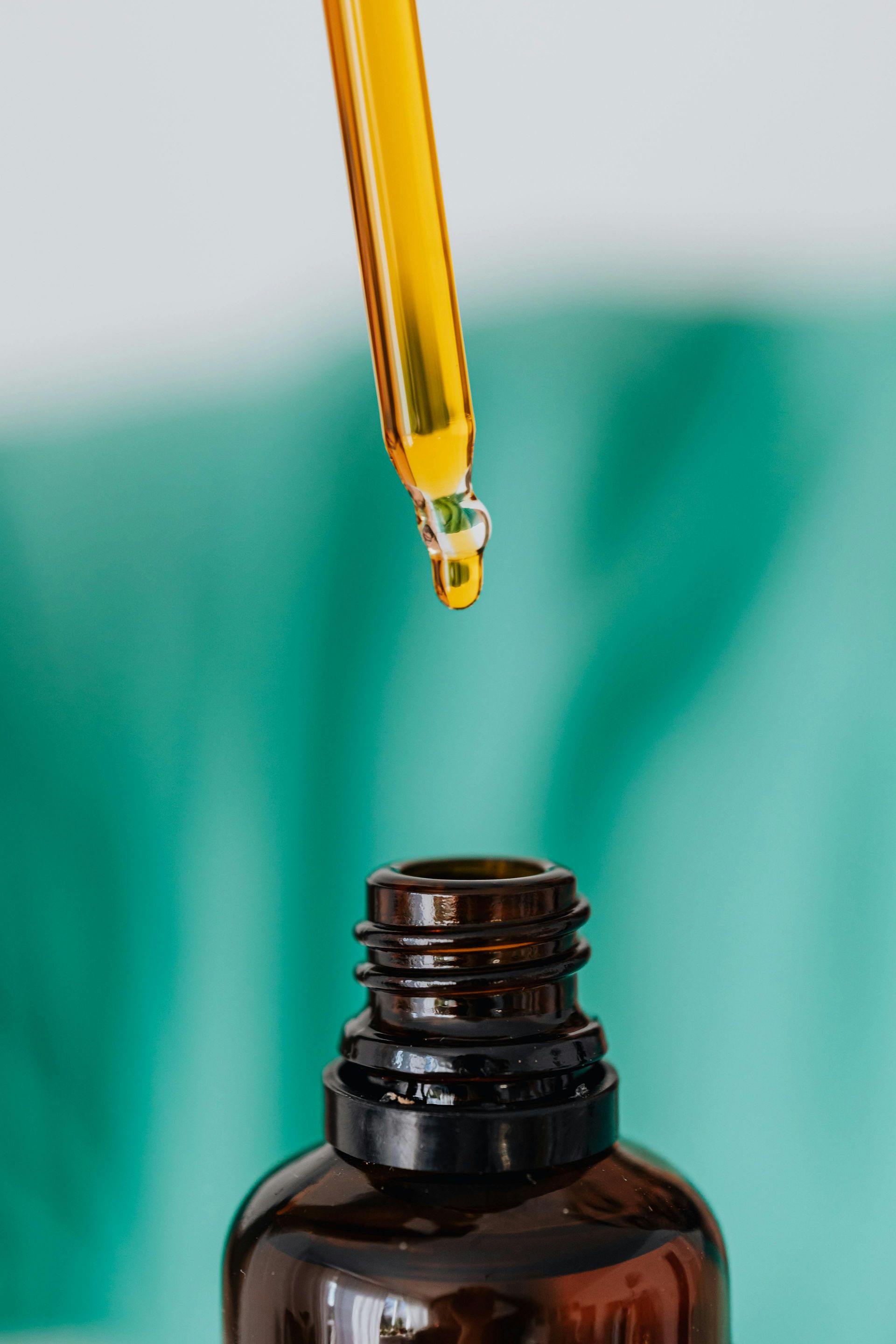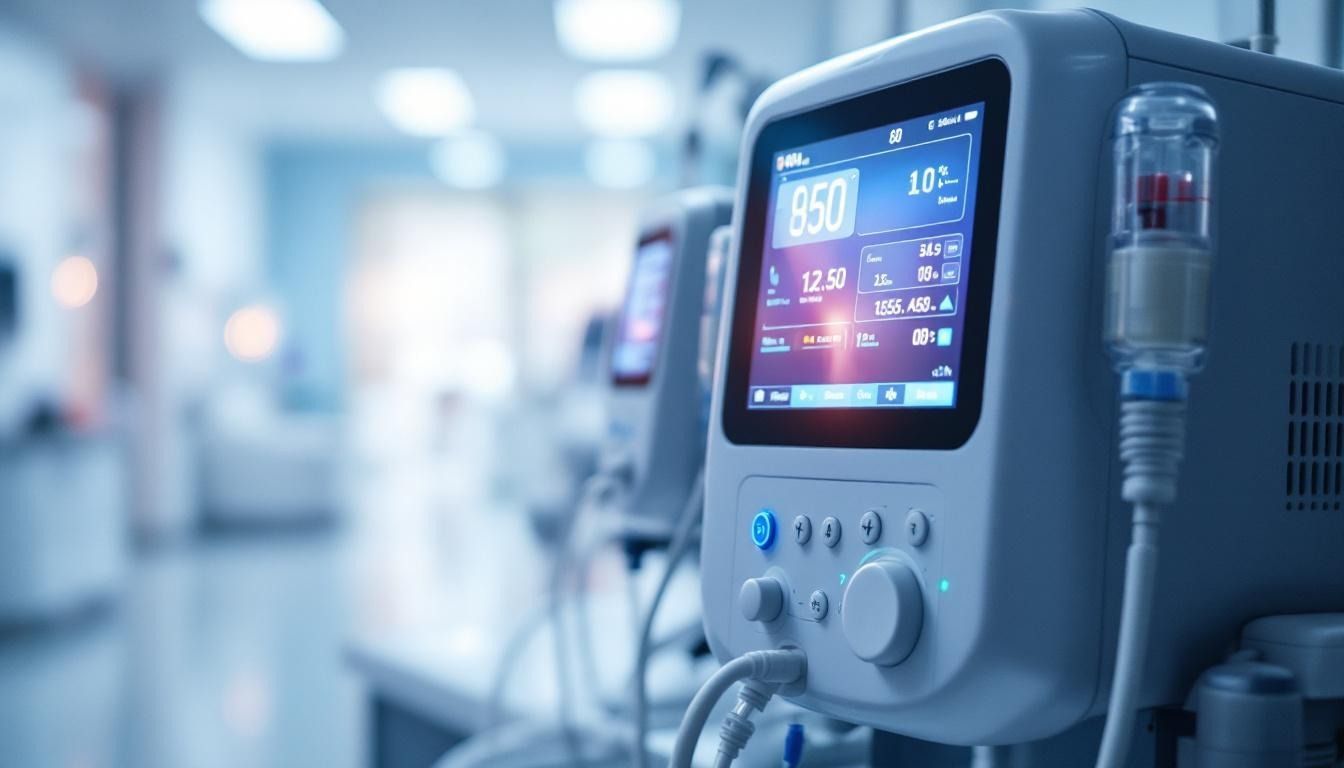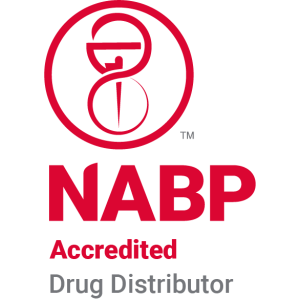IDPN benefits during hemodialysis
Understanding the Role of IDPN in Hemodialysis Patients
Intradialytic Parenteral Nutrition (IDPN) is a specialized nutritional intervention administered during hemodialysis sessions to address malnutrition and protein-energy wasting in patients with chronic kidney disease. While its theoretical benefits include improving nutritional biomarkers and supporting overall health, current clinical evidence presents a nuanced picture. This article explores the mechanisms, clinical outcomes, safety considerations, guidelines, and ongoing debates surrounding IDPN during hemodialysis, providing a comprehensive overview for clinicians and researchers alike.
Definition and Composition of IDPN
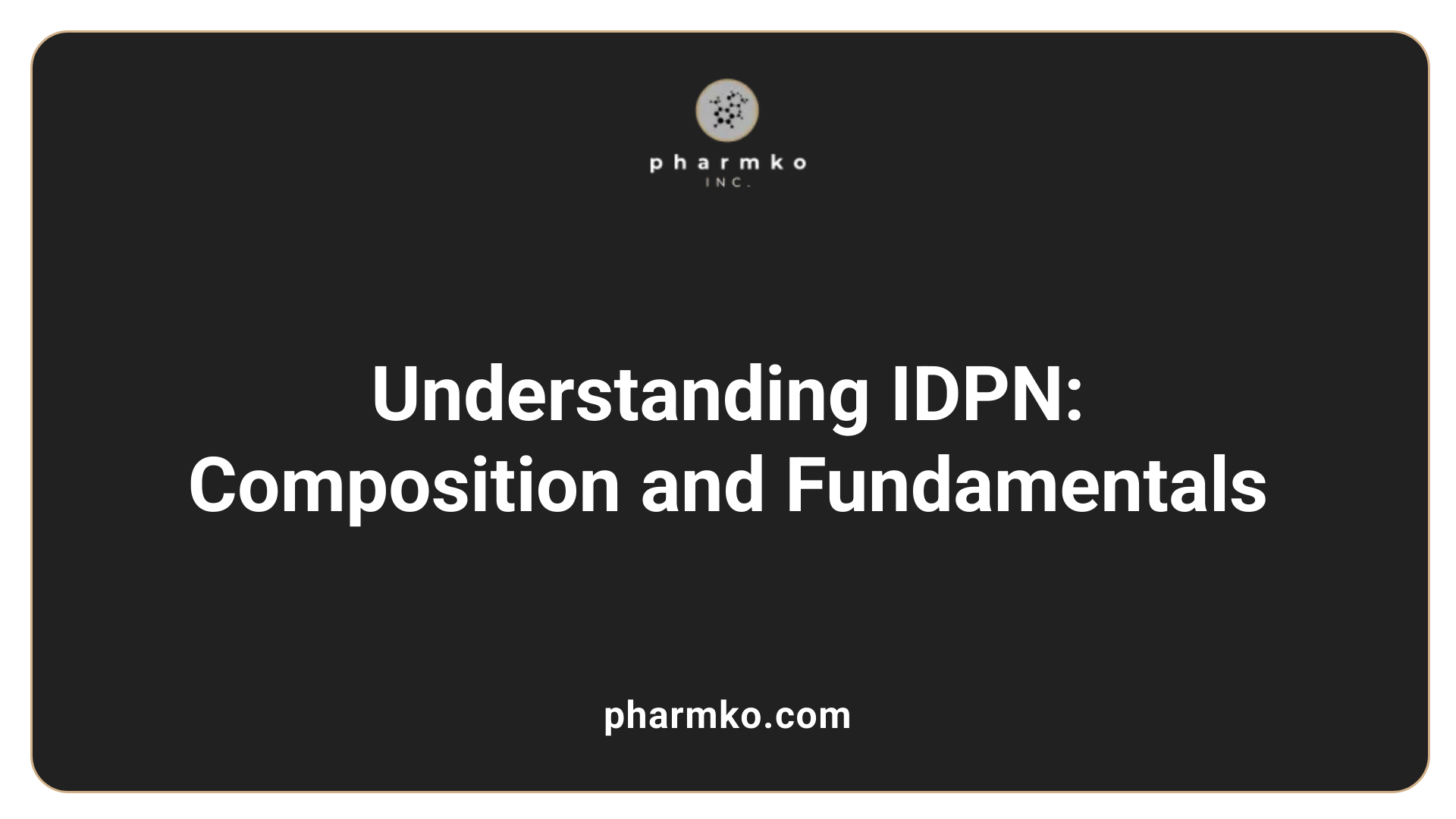
What does IDPN stand for?
IDPN, or Intradialytic Parenteral Nutrition, is a form of nutritional support provided during hemodialysis sessions. It involves delivering a carefully formulated mixture of nutrients directly into the bloodstream of patients undergoing dialysis. This approach aims to help those who are malnourished or experiencing protein-energy wasting, conditions common among chronic kidney disease patients.
During dialysis, the body's metabolism can be compromised, and nutritional needs are often not met through diet alone. IDPN serves as an adjunct therapy, ensuring essential nutrients are supplied effectively and safely.
What are the typical components of IDPN solutions?
IDPN solutions are customized based on individual patients' nutritional requirements. They generally comprise several key ingredients:
| Component | Purpose | Additional Details |
|---|---|---|
| Amino acids | Provide building blocks for protein synthesis | Available as part of a three-in-one solution or separately |
| Dextrose | Supply calories and energy | Typically dextrose, a form of glucose, is used for energy |
| Lipids | Deliver essential fatty acids and calories | Often derived from fish oil or other lipid emulsions |
| Vitamins and minerals | Support metabolic processes and overall health | Supplementation needed to meet daily requirements |
These components are prepared under strict clinical protocols to meet the specific needs of each patient.
How is IDPN administered during dialysis?
IDPN is administered during hemodialysis sessions via a venous infusion. Utilizing a specialized infusion pump, the nutrient mixture is delivered at a constant rate into the blood circuit. This method ensures continuous and controlled infusion during the entire dialysis treatment, typically lasting several hours.
The process involves inserting a catheter or utilizing existing access to infuse the solution directly into the bloodstream. Monitoring is essential throughout the procedure to detect and manage potential adverse effects such as hyperglycemia, allergic reactions, or lipid abnormalities.
Overall, IDPN infusion during dialysis provides a supplement of calories, amino acids, and lipids that helps mitigate the catabolic effects of dialysis and supports the nutritional status of vulnerable patients.
Typical Composition and Delivery of IDPN
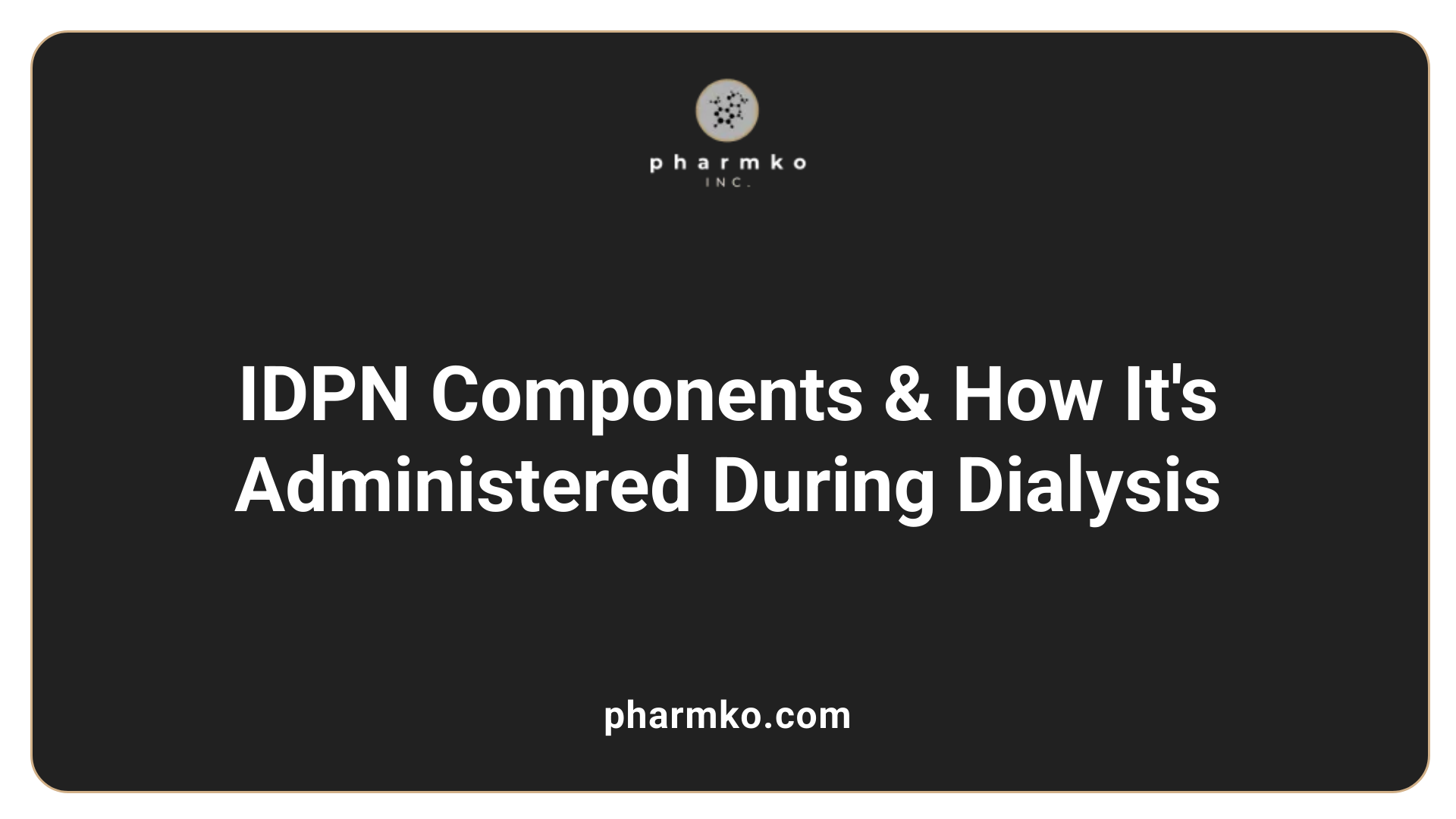
What are the components of IDPN solutions?
IDPN solutions are carefully formulated to provide essential nutrients directly into the bloodstream during dialysis sessions. The main ingredients include amino acids, which supply protein building blocks necessary for tissue maintenance and repair.
Dextrose, a form of glucose, serves as a vital energy source, helping to meet the caloric needs of malnourished patients. Lipids, usually from fish oil-based sources, are added to supply essential fatty acids and additional calories.
In addition to these macronutrients, vitamins and minerals are incorporated to address micronutrient deficiencies and support overall metabolic functions.
These components can be combined into comprehensive formulations known as three-in-one solutions, which include amino acids, dextrose, and lipids in a single infusion. Alternatively, they can be given as separate components, tailored to a patient's specific nutritional needs.
How is IDPN administered during dialysis?
The infusion of IDPN occurs during hemodialysis sessions, delivered directly into the patient’s venous circulation. This process utilizes an infusion pump calibrated to control the rate of nutrient delivery.
The setup involves connecting the nutrient solution to the dialysis circuit, ensuring continuous infusion throughout the treatment period, which typically lasts several hours. This method maximizes nutrient absorption and utilization, while also minimizing the risk of complications.
During administration, healthcare providers closely monitor the patient for potential adverse reactions, such as hyperglycemia, lipid abnormalities, or procedural issues. Laboratory tests are routinely performed between dialysis sessions to ensure the adequacy and safety of the nutritional therapy.
This targeted approach helps address malnutrition by providing a steady supply of calories and proteins, enhancing the patient’s nutritional status and potentially improving clinical outcomes.
Mechanisms Underlying Nutritional Support During Dialysis
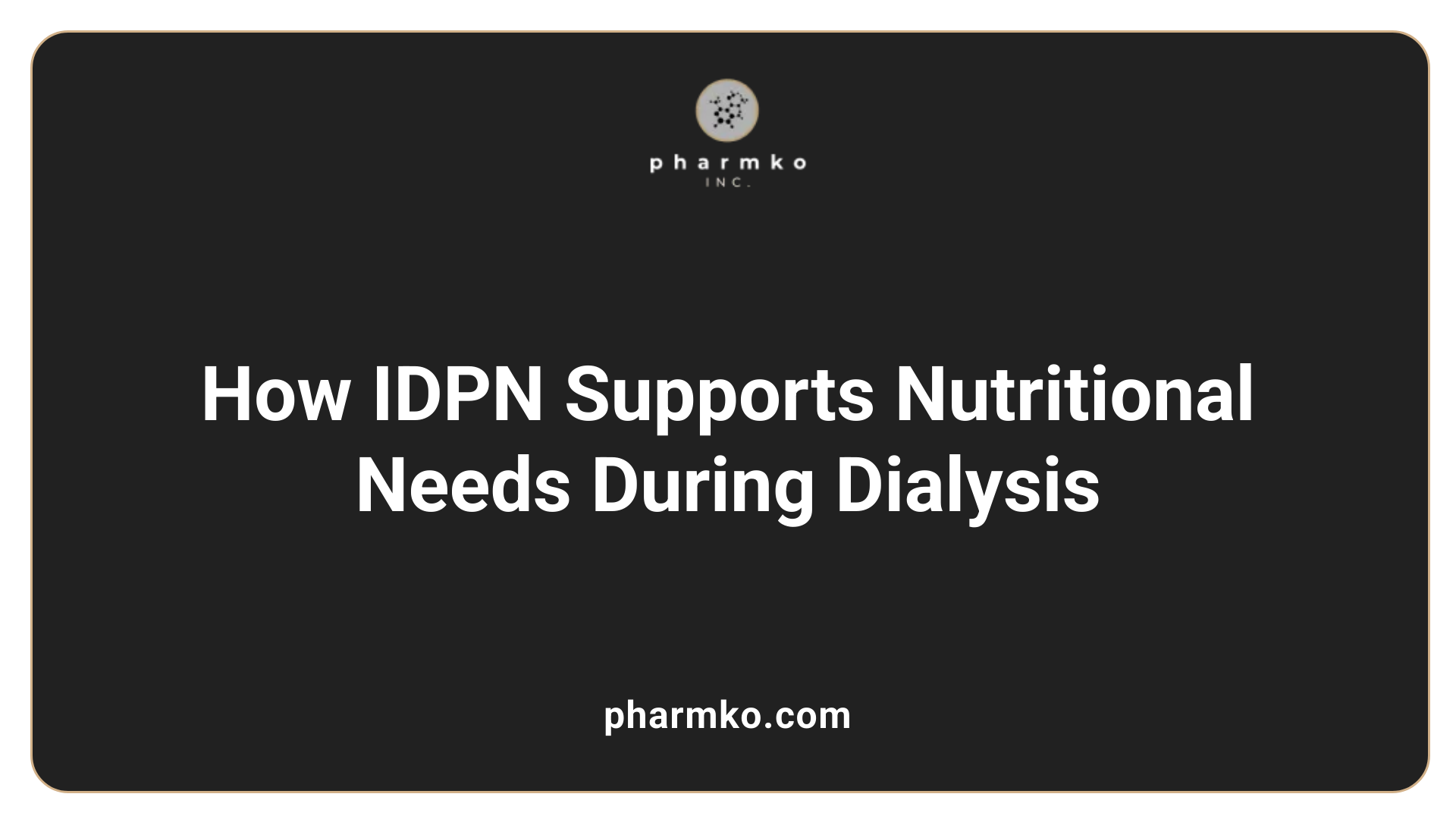
How does IDPN counteract malnutrition?
IDPN (Intradialytic Parenteral Nutrition) delivers vital nutrients directly into the bloodstream during dialysis sessions. This method provides calories, amino acids, and lipids to patients who cannot meet their nutritional needs through oral intake alone. By supplying these essential nutrients, IDPN helps replenish energy and protein stores that are often depleted in hemodialysis patients.
This targeted nutritional support can lead to improvements in body weight and muscle mass, addressing malnutrition effectively. It is especially useful for patients who experience significant weight loss or have difficulty swallowing or absorbing nutrients due to gastrointestinal issues.
What role does IDPN play in protein and energy homeostasis?
IDPN plays a central role in stabilizing the balance of protein and energy within the body. It provides a rich supply of amino acids and glucose, the building blocks for proteins and energy, respectively. Through continuous infusion during dialysis, IDPN helps maintain stable serum levels of prealbumin, albumin, and other nutritional markers.
Clinical studies have shown that IDPN can increase serum albumin and prealbumin levels, which are important indicators of nutritional health. Additionally, it supports positive nitrogen balance, essential for tissue repair and muscle synthesis.
How does IDPN influence catabolic processes during dialysis?
Dialysis is a catabolic process, often leading to muscle breakdown and protein-energy wasting (PEW) in patients with chronic kidney disease. IDPN helps counteract these adverse effects by providing nutrients that suppress catabolism.
By supplying amino acids and calories during the dialysis session, IDPN reduces the extent of muscle degradation, thus preserving lean body mass. It also aids in reducing inflammation markers like C-reactive protein, further supporting a more anabolic, less catabolic environment.
In sum, IDPN supports the maintenance of nutritional status by supplying essential nutrients, promoting energy and protein conservation, and mitigating the catabolic impact of dialysis treatments.
Clinical Evidence and Effectiveness of IDPN
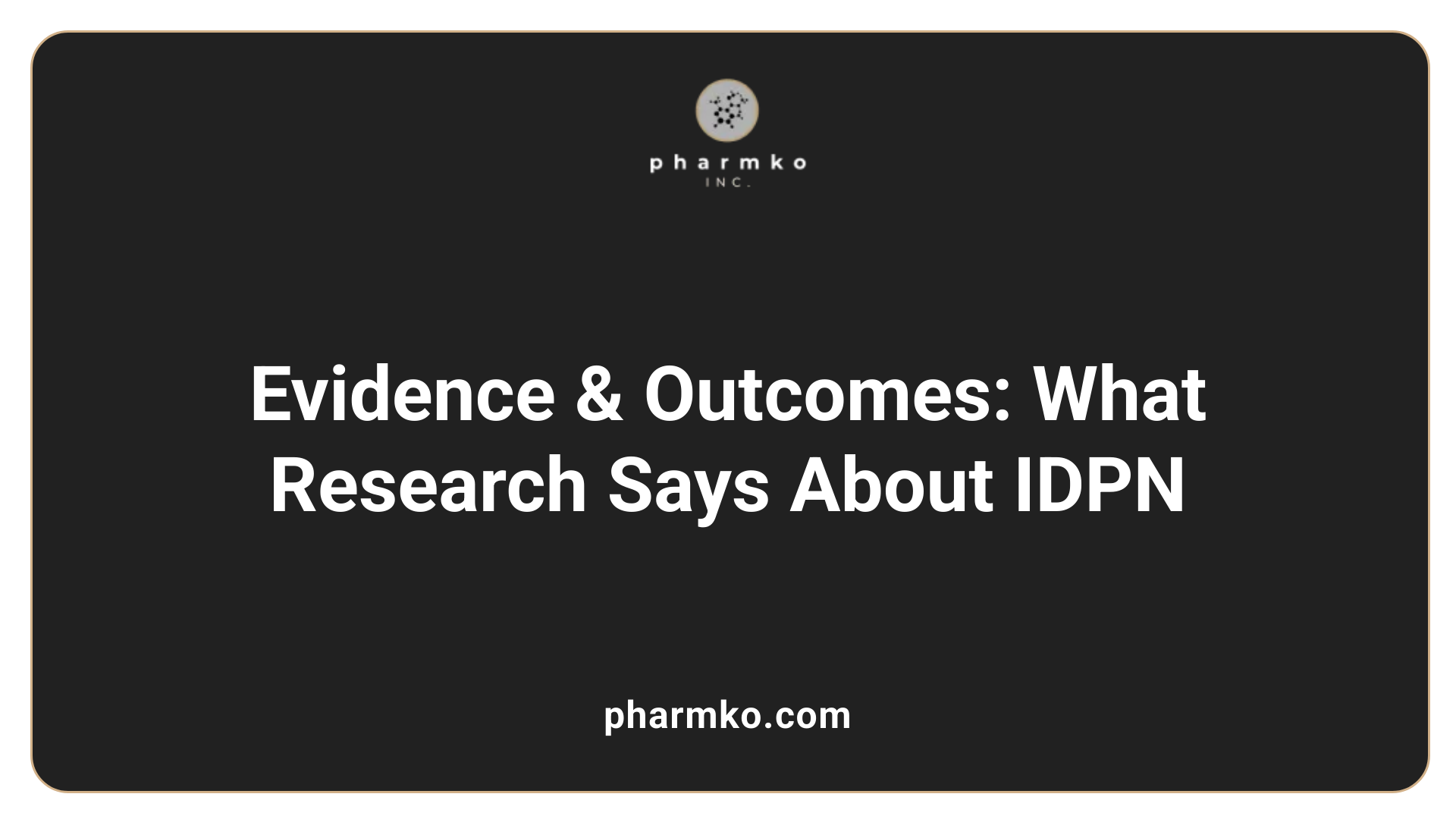
What do systematic reviews and RCTs show about IDPN benefits?
Systematic reviews and randomized controlled trials (RCTs) have extensively studied the usefulness of intradialytic parenteral nutrition (IDPN) in hemodialysis patients. Despite its widespread use, the current evidence shows that IDPN does not reliably improve substantial health outcomes like mortality, hospitalization rates, or overall quality of life. While some trials have observed minor improvements in nutritional markers—such as serum albumin, prealbumin, and normalized protein catabolic rate—these biochemical changes do not consistently lead to meaningful clinical benefits.
Research indicates that IDPN provides calories and protein to supplement inadequate oral intake, which may aid in maintaining nutritional status. However, this supplementation alone has not been conclusively linked to longer survival or reduced hospitalization in large-scale studies. The improvements seen in laboratory-based nutritional indicators often do not translate into tangible health outcomes, leading to ongoing debate about its overall value.
Does IDPN improve clinical outcomes such as survival or hospitalization?
Current clinical trials and reviews suggest that IDPN does not significantly enhance survival rates or reduce hospital admissions for dialysis patients. Although some retrospective studies and smaller trials have reported increased serum albumin levels and possible survival benefits in patients with severe malnutrition, these findings are inconsistent and limited by design.
Most guidelines recommend reserving IDPN for specific cases, such as patients who fail to respond to dietary counseling or oral nutritional supplements. The primary goal remains to improve nutritional status rather than to alter long-term clinical outcomes directly. The evidence does not convincingly support routine use of IDPN solely for mortality reduction or health care cost savings.
What are the changes in nutritional markers like serum albumin?
IDPN does lead to improvements in several nutritional markers. Numerous studies report increases in serum albumin, prealbumin, and other indicators of protein and energy status during therapy. These markers are important as they reflect the body's nutritional reserve and inflammatory state.
For instance, some research demonstrates that IDPN can raise serum albumin levels, which is associated with lower mortality in dialysis patients. Improvements in body weight, appetite, and nitrogen balance are also observed, especially in patients who are severely malnourished or unable to tolerate oral foods.
However, these laboratory improvements should be interpreted with caution. The rise in serum albumin may not necessarily translate into better clinical outcomes such as survival or reduced hospitalizations. Moreover, transient or short-term enhancements in these markers may not be sustained over longer periods or lead to changes in overall patient health.
| Study Type | Nutritional Markers Improved | Associated Outcomes | Limitations |
|---|---|---|---|
| RCTs | Serum albumin, prealbumin, nPCR | Some reports of survival benefit in malnourished | Not consistent; improvements don't always translate into better health outcomes |
| Retrospective studies | Body weight, appetite, nutritional scores | Potential survival enhancement in certain groups | Less controlled, potential biases |
| Systematic reviews | Laboratory nutritional indices | No conclusive evidence on mortality or morbidity | Focus on biochemical rather than clinical benefits |
More detailed information
Further research continues to explore the potential of IDPN, especially in niche patient populations with severe nutritional deficits or specific gastrointestinal issues. Still, the prevailing consensus underscores that nutritional biochemical improvements alone should not be the sole reason for implementing IDPN.
The development of guidelines emphasizes using IDPN as a last resort after failed dietary and oral interventions, given the limited evidence of long-term benefits. The primary focus remains on comprehensive nutritional management, monitoring laboratory markers, and tailoring therapy to individual patient needs.
Safety Profile and Adverse Events of IDPN

What are the side effects associated with IDPN?
IDPN therapy is generally well tolerated by most patients. Common side effects include gastrointestinal symptoms such as nausea, vomiting, diarrhea, and flushing. These are often related to the infusion process or components of the solution, like lipids and glucose. Lipid administration reactions are less frequent but can occur, especially if the infusion rate is too rapid. Proper monitoring of infusion rates, patient tolerance, and dose adjustments can effectively reduce these adverse effects.
How are adverse events managed?
Adverse events during IDPN are managed through vigilant monitoring of patients during and after infusions. Laboratory tests, such as blood glucose levels, lipid profiles, and markers of inflammation, are regularly checked to detect early signs of complications. If adverse reactions like hyperglycemia or lipid abnormalities occur, clinicians may slow or temporarily halt infusions, adjust the nutrient composition, or provide supportive treatments. Ensuring proper infusion techniques and patient education about symptoms also contributes to safe administration.
What is the safety profile of IDPN?
Overall, the safety profile of IDPN is favorable when implemented according to established guidelines. Studies and clinical use indicate that IDPN does not significantly increase the risk of serious adverse events such as infections, metabolic disturbances, or procedural complications.
Current evidence suggests that, with appropriate patient selection and careful monitoring, IDPN is a safe adjunct therapy for addressing malnutrition in hemodialysis patients. The therapies’ safety benefits are further supported by data showing no increase in harm when compared to other nutritional or supportive treatments.
In summary, while minor adverse events can occur, they are manageable and do not detract from the overall safety of IDPN. Proper protocols and vigilant patient management are essential to ensuring safe use of this nutritional intervention.
Guidelines and Indications for IDPN Use
When is IDPN recommended?
Guidelines suggest that intradialytic parenteral nutrition (IDPN) should be considered only after other nutritional strategies, such as dietary counseling and oral supplementation, have failed. It is primarily recommended for patients with severe malnutrition who cannot absorb enough nutrients through the gastrointestinal tract. IDPN is often used as a last resort or a refractory treatment when standard nutritional approaches are insufficient.
Ownership of IDPN therapy is supported in cases where patients experience persistent weight loss, low serum albumin, or muscle wasting despite optimized oral intake. The therapy aims to provide direct vascular delivery of calories and proteins during dialysis sessions, helping to address malnutrition.
What are the criteria for initiation?
The decision to begin IDPN typically involves a thorough nutritional assessment. Suitable candidates often display evidence such as significant weight loss (5-10%), low body mass index (less than 20), or documented gastrointestinal issues like gastroparesis or malabsorption.
Assessment tools like the Subjective Global Assessment (SGA) focusing on categories B or C, combined with laboratory indicators such as decreased serum albumin or prealbumin, help determine the need for IDPN. Patients should also demonstrate adequate dialysis clearance, meaning that their uremic toxins are well-controlled.
The therapy is generally structured to last at least 4 to 6 months, with the goal of improving overall nutritional status and body composition.
Are there contraindications to IDPN?
IDPN should be avoided in certain conditions where risks outweigh potential benefits. Contraindications include volume overload, uncontrolled hyperglycemia, or significant lipid abnormalities like hyperlipidemia or fatty liver.
If adverse effects such as hyperglycemia, infection, or procedural complications occur during therapy, discontinuation is considered. Monitoring for these complications involves routine laboratory tests and clinical assessments.
Discontinuing IDPN occurs when nutritional objectives, such as improved albumin levels and weight stabilization, are achieved or when complications arise that pose excessive health risks.
| Criteria | Details | Additional Information |
|---|---|---|
| Nutritional indicators | Significant weight loss, low BMI, low serum albumin/prealbumin | Critical in assessment decision |
| Gastrointestinal assessment | Evidence of malabsorption, gastroparesis, inadequate oral intake | Affects responsiveness to oral nutrition |
| Dialysis adequacy | Achieved adequate clearance (Kt/V or urea reduction ratio) | Ensures nutrient delivery is feasible |
| Monitoring parameters | Blood glucose, lipid profile, signs of infection | Helps identify adverse effects early |
By following these guidelines, clinicians can better determine when IDPN may be beneficial and safely implement this therapy in suitable hemodialysis patients.
Cost-Effectiveness and Economic Considerations
What do studies say about the cost of IDPN?
Current research indicates that intradialytic parenteral nutrition (IDPN) is associated with significant costs due to the need for specialized solutions, infusion equipment, and monitoring during dialysis sessions. While it provides nutritional supplementation during treatment, its higher expenses are not always justified by clear health benefits.
Are there savings associated with IDPN?
Based on available data, IDPN does not demonstrate consistent cost savings in the management of malnutrition among hemodialysis patients. Although it may improve certain nutritional markers temporarily, these improvements do not translate into reduced hospitalizations or decreased long-term healthcare costs. In fact, considering its expenses, IDPN can sometimes add to the financial burden rather than alleviate it.
How do benefits compare to costs?
The clinical benefits of IDPN, such as modest increases in serum albumin or body weight, do not appear to outweigh its financial costs. Many guidelines suggest limiting its use to cases where oral or enteral nutrition methods have failed. Given the limited evidence of overall health outcome improvements and the lack of proven mortality or hospitalization benefits, the economic viability of routine IDPN remains uncertain.
| Aspect | Findings | Implications |
|---|---|---|
| Cost of Solutions | High due to individualized formulations | Adds financial burden without guaranteed benefits |
| Healthcare Savings | No consistent reduction in hospitalization or mortality | Limited economic benefits |
| Cost vs. Benefits | Benefits in nutritional markers are minimal and not sustained | Routine use is not cost-effective |
While IDPN can improve some nutritional parameters temporarily, its high costs and the absence of clear evidence for long-term advantages suggest that its economic value remains questionable. More rigorous cost-benefit analyses are needed to better understand its role within the broader management of nutritional issues in dialysis patients.
Perspectives and Future Directions in IDPN Therapy
What do expert opinions say about IDPN?
Experts recognize Intradialytic Parenteral Nutrition (IDPN) as a supportive therapy that can be considered under specific circumstances for patients undergoing hemodialysis. They emphasize the importance of careful patient selection and diligent monitoring during therapy. While the current evidence does not strongly support routine use due to limited impact on long-term outcomes such as mortality or hospitalization, many clinicians agree that IDPN remains a valuable tool for patients with severe, refractory malnutrition who do not respond to dietary counseling or oral supplements.
Professional guidelines recommend IDPN only after failure of less invasive nutritional strategies. Experts highlight that, in such cases, IDPN can help improve nutritional markers like serum albumin and prealbumin, and may contribute to maintaining nitrogen balance and reducing the catabolic effects of dialysis. Nonetheless, they caution that IDPN should not be viewed as a universal solution but as part of a comprehensive, individualized approach to nutritional management in dialysis patients.
Potential areas for research
Despite some positive indications, significant gaps remain in the understanding of IDPN’s full benefits. Future research should prioritize well-structured randomized controlled trials that evaluate the long-term effects of IDPN on survival, hospitalization rates, and quality of life. Such studies need to clarify whether improvements in nutritional markers genuinely translate into meaningful health benefits.
Another promising area involves personalized treatment protocols. Advances in biomarker research might enable clinicians to predict which patients are most likely to benefit from IDPN. Investigating the role of specific nutritional and inflammatory markers could help tailor interventions more effectively.
Cost-effectiveness analyses are also crucial, especially given the high costs associated with IDPN formulations. Future studies should assess whether the nutritional benefits justify the expenditure, particularly when compared with other less invasive therapies.
The future role of IDPN in dialysis care
IDPN’s future in dialysis care hinges on accumulating robust evidence demonstrating clear clinical benefits. As research progresses, it may become part of targeted nutritional interventions for select patient groups—particularly those with severe protein-energy wasting unresponsive to standard treatments.
Technological advances in infusion delivery and monitoring could enhance safety and efficacy, making IDPN more adaptable to patient needs. Additionally, integrating nutritional assessment tools and biomarkers into routine dialysis care could facilitate early identification of malnutrition and timely initiation of interventions like IDPN.
In the coming years, multidisciplinary care teams—including nephrologists, dietitians, and researchers—will likely refine guidelines to optimize when and how IDPN is employed. The focus remains on improving patient-centered outcomes, ensuring that the therapy's use is both evidence-based and tailored to individual patient circumstances.
Summary and Practical Recommendations
When should IDPN be considered?
IDPN is generally reserved for patients undergoing hemodialysis who suffer from severe malnutrition and have not responded to less invasive nutritional interventions. These include dietary counseling and oral or enteral supplements. Current guidelines advise considering IDPN only after these standard measures fail, particularly in cases where gastrointestinal absorption is impaired or when patients have significant protein-energy wasting that jeopardizes their health.
While some retrospective studies suggest that IDPN might improve serum albumin and survival in select patients, there is no definitive evidence from randomized controlled trials demonstrating that it reduces mortality, hospitalization, or improves quality of life for the broader patient population. Therefore, the primary use of IDPN remains as a targeted, refractory therapy rather than routine prophylactic supplementation.
What are the key considerations for implementation?
Successful implementation hinges on proper patient selection, adherence to clinical guidelines, and individualized formulation. Patients should be evaluated for malnutrition severity using assessments like the Subjective Global Assessment (SGA), body weight trends, BMI, and dietary intake. Nutritional goals should be set to improve serum protein markers and overall energy stores.
Formulations typically contain amino acids, dextrose, and lipids, tailored to meet each patient’s specific needs. The therapy usually runs for at least 4 to 6 months, aiming to correct nutritional deficiencies without causing adverse effects such as volume overload or hyperglycemia. Regular monitoring is essential to assess nutritional response and to avoid complications.
How should patients be monitored?
Monitoring is a critical component of IDPN therapy. It includes regular laboratory assessments, such as serum albumin, prealbumin, and total protein levels, to gauge nutritional status. Blood glucose levels should be closely watched to detect hyperglycemia, especially in diabetic patients. Lipid levels and signs of fat intolerance must also be checked.
Clinical vigilance is necessary for adverse events like infections, muscle pain, or procedural complications related to infusion. Continuous assessment of weight, appetite, and functional status can provide additional insights into therapy effectiveness. Adjustments to the infusion composition or discontinuation should be made based on achieving nutritional goals and the emergence of any adverse effects.
| Aspect | Consideration | Details |
|---|---|---|
| Timing | When to start | After failure of initial nutritional strategies |
| Duration | How long | Typically at least 4–6 months |
| Formulation | What's included | Amino acids, dextrose, lipids, customized per patient |
| Monitoring | What to check | Serum albumin, prealbumin, glucose, lipids, clinical signs |
| Discontinuation | When to end | Nutritional goals met or adverse effects observed |
By adhering to these guidelines, clinicians can ensure that IDPN is used effectively, safely, and appropriately, maximizing potential benefits while minimizing risks for patients undergoing hemodialysis.
Conclusion: Balancing Benefits and Limitations
What is the overall outlook on IDPN during hemodialysis?
Intradialytic parenteral nutrition (IDPN) offers some advantages, such as raising serum albumin levels and improving nutritional markers like prealbumin and nitrogen balance. It can help mitigate protein-energy wasting and support body weight maintenance in malnourished dialysis patients. However, current high-quality evidence indicates that IDPN does not consistently translate into meaningful improvements in crucial clinical outcomes like reduced mortality, fewer hospitalizations, or enhanced quality of life. Consequently, its application should be individualized, carefully weighing potential nutritional benefits against economic considerations and patient-specific factors.
What are the main limitations of current evidence?
The scientific data underpinning IDPN effectiveness face several challenges. Many studies are limited by small sample sizes, diverse patient populations, and varying clinical protocols, making it difficult to draw definitive conclusions. Additionally, outcome measures like serum albumin, while indicative of nutritional status, do not reliably predict long-term health benefits or survival. The lack of standardized trial designs and consistent follow-up periods further complicates comprehensive assessments. Without robust long-term data, recommendations remain cautious, emphasizing the need for more rigorous research.
How might future research influence IDPN use?
Advances in research could clarify the true value of IDPN in managing malnutrition among dialysis patients. Future investigations should focus on high-quality, large-scale randomized controlled trials that evaluate not only nutritional markers but also meaningful clinical endpoints such as survival rates, hospitalizations, and quality of life. Cost-effectiveness analyses are also vital to ensure healthcare resources are used efficiently. Personalized nutrition strategies, guided by detailed patient assessments and biomarkers, could optimize who benefits most from IDPN. As evidence accumulates, clinical guidelines may evolve to better define the indications, duration, and protocols for IDPN, ensuring its use is both evidence-based and patient-centered.
Final Thoughts on IDPN in Dialysis Care
Intradialytic Parenteral Nutrition remains a promising yet controversial approach in managing malnutrition among hemodialysis patients. While it offers potential improvements in nutritional parameters like serum albumin and body weight, the current evidence does not conclusively demonstrate significant benefits in patient-centered outcomes such as survival or quality of life. Its safety profile appears acceptable when properly monitored, and guideline recommendations support its use primarily as a refractory intervention after less invasive methods. Future research should aim to solidify the evidence base, refine patient selection, and evaluate long-term impacts to better define the precise role of IDPN in dialysis care. Clinicians should weigh the modest nutritional improvements against the costs, logistical demands, and uncertain long-term benefits when considering IDPN as part of a comprehensive nutritional strategy.
References
- Evidence Brief: Use of Intradialytic Parenteral Nutrition (IDPN ... - NCBI
- [PDF] Intradialytic Parenteral Nutrition (IDPN) - BC Renal
- Intradialytic Parenteral Nutrition
- Intradialytic Parenteral Nutrition - an overview | ScienceDirect Topics
- Benefits of IDPN and IPN - Patient Care America
- The beneficial effects of intradialytic parenteral nutrition in ... - Nature
- [PDF] How IDPN & IPN therapy can benefit your patients.



